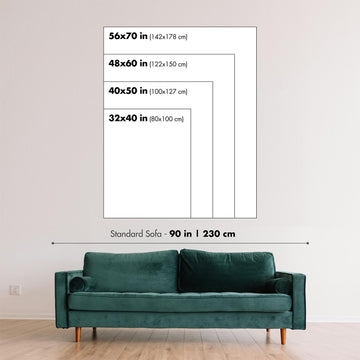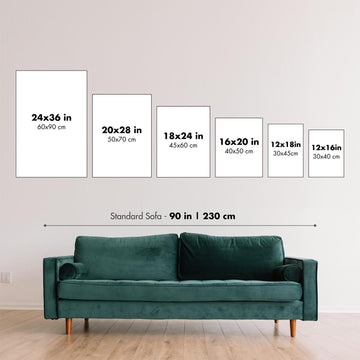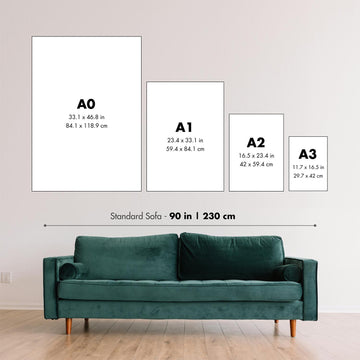

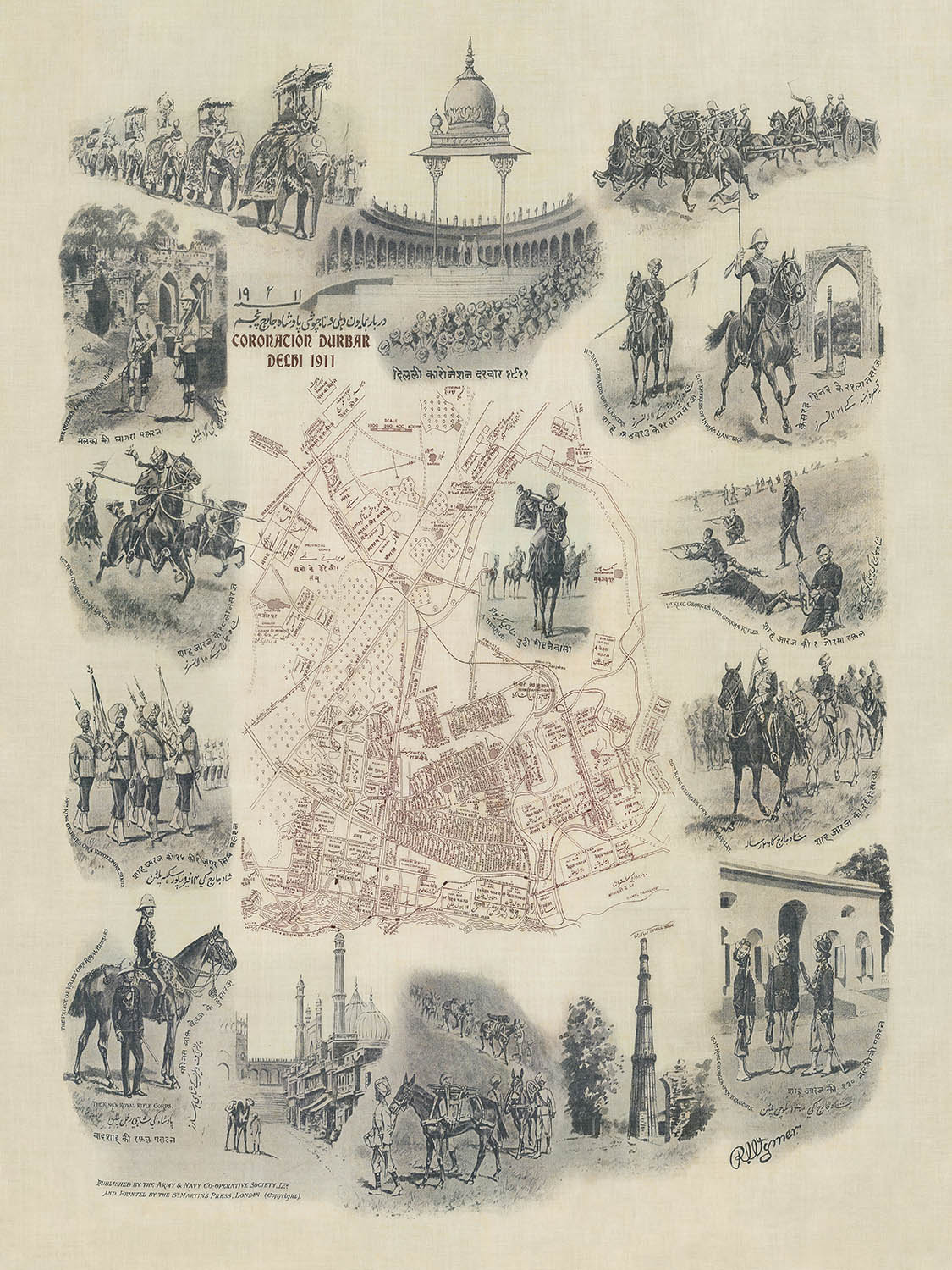

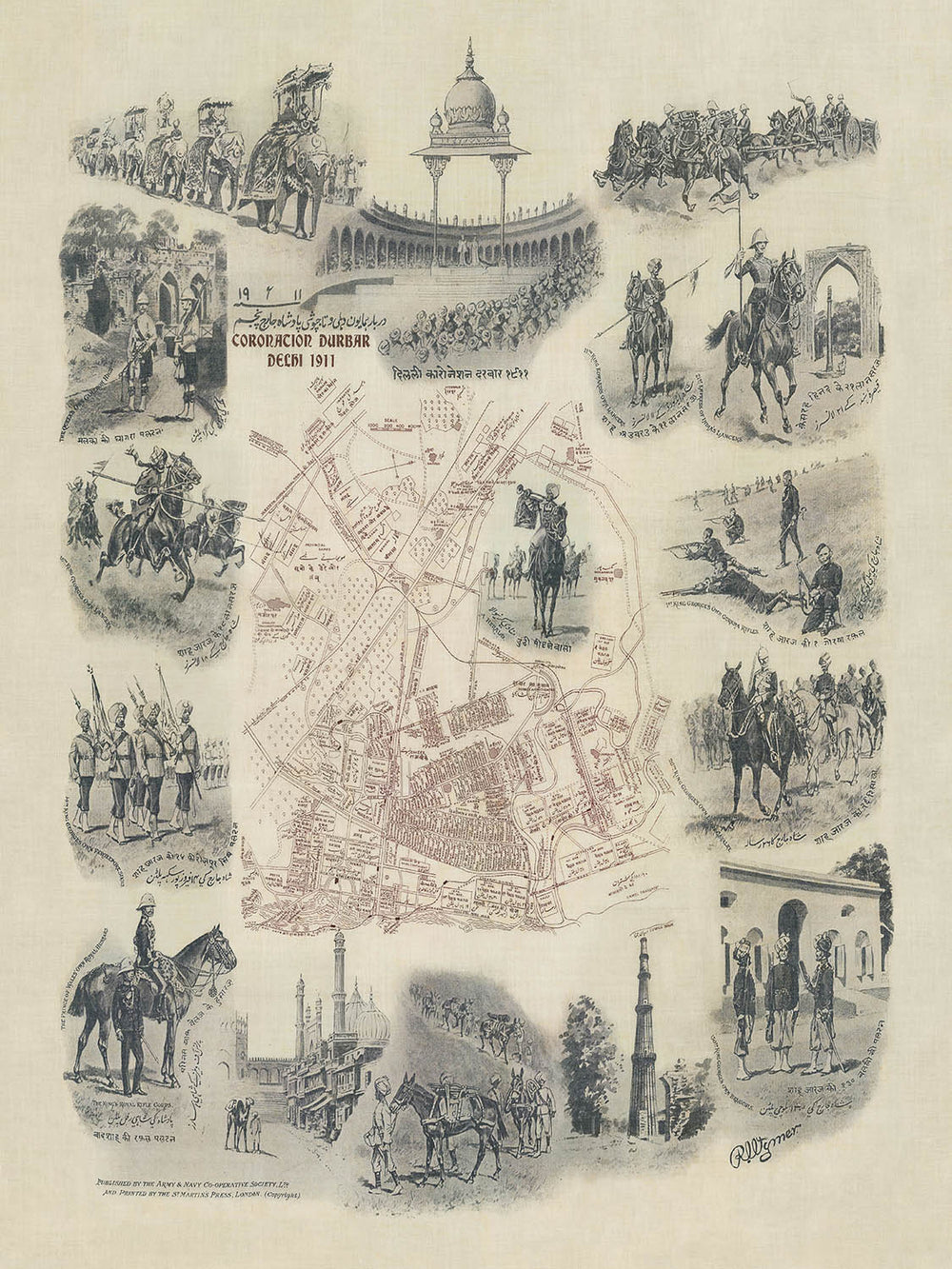

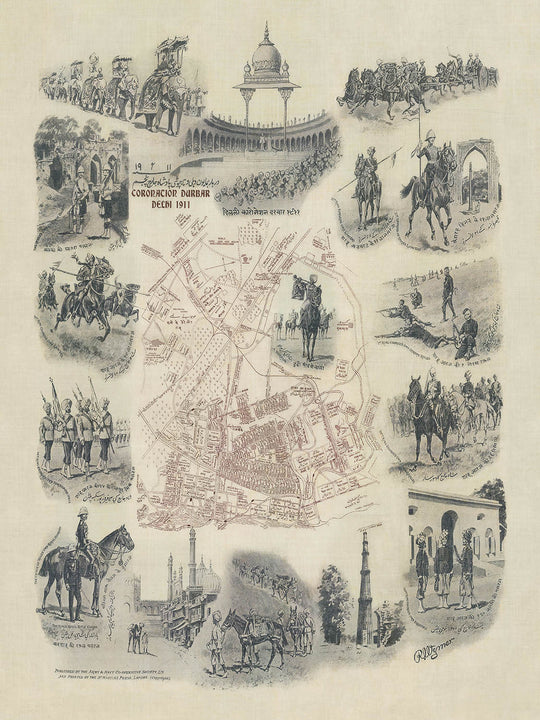












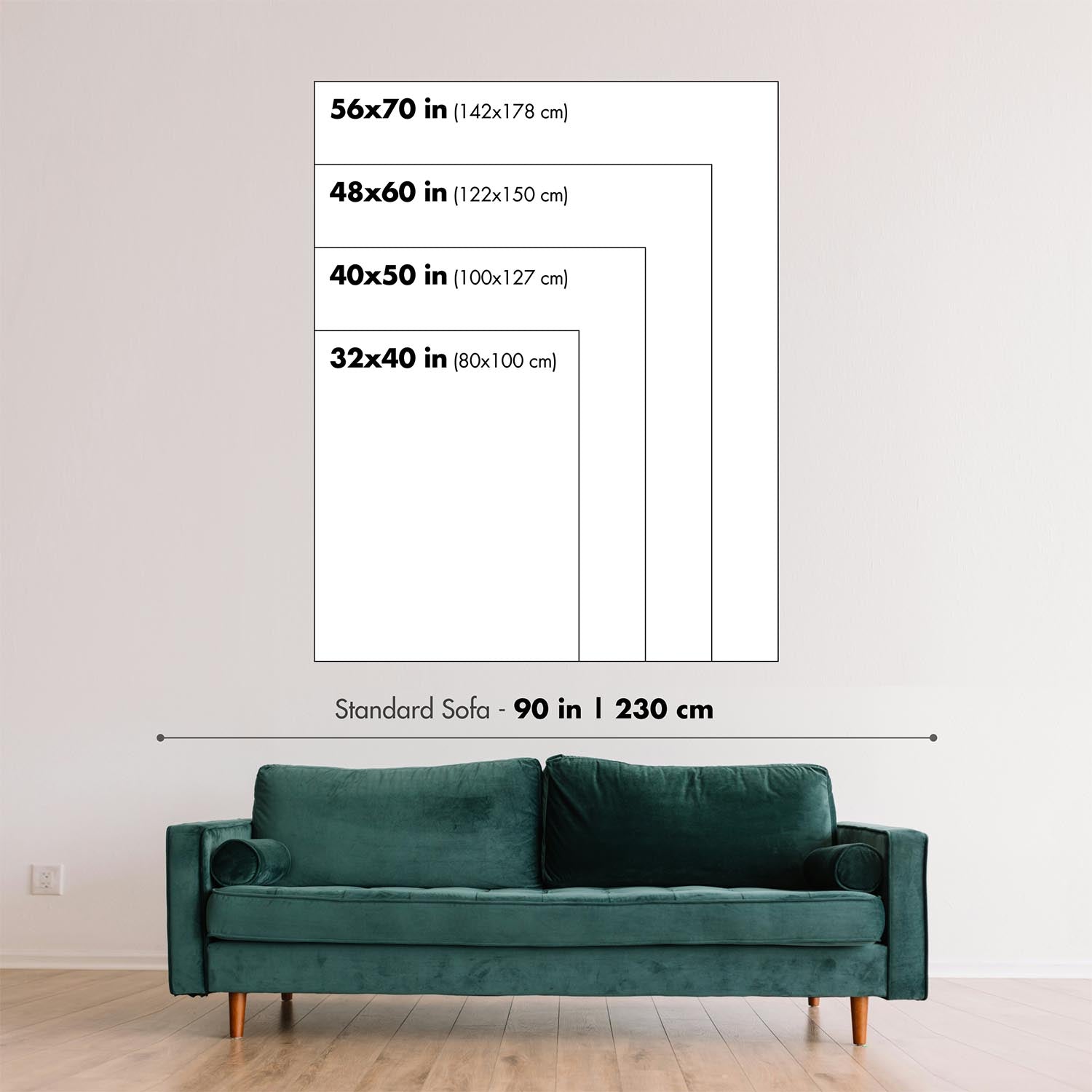
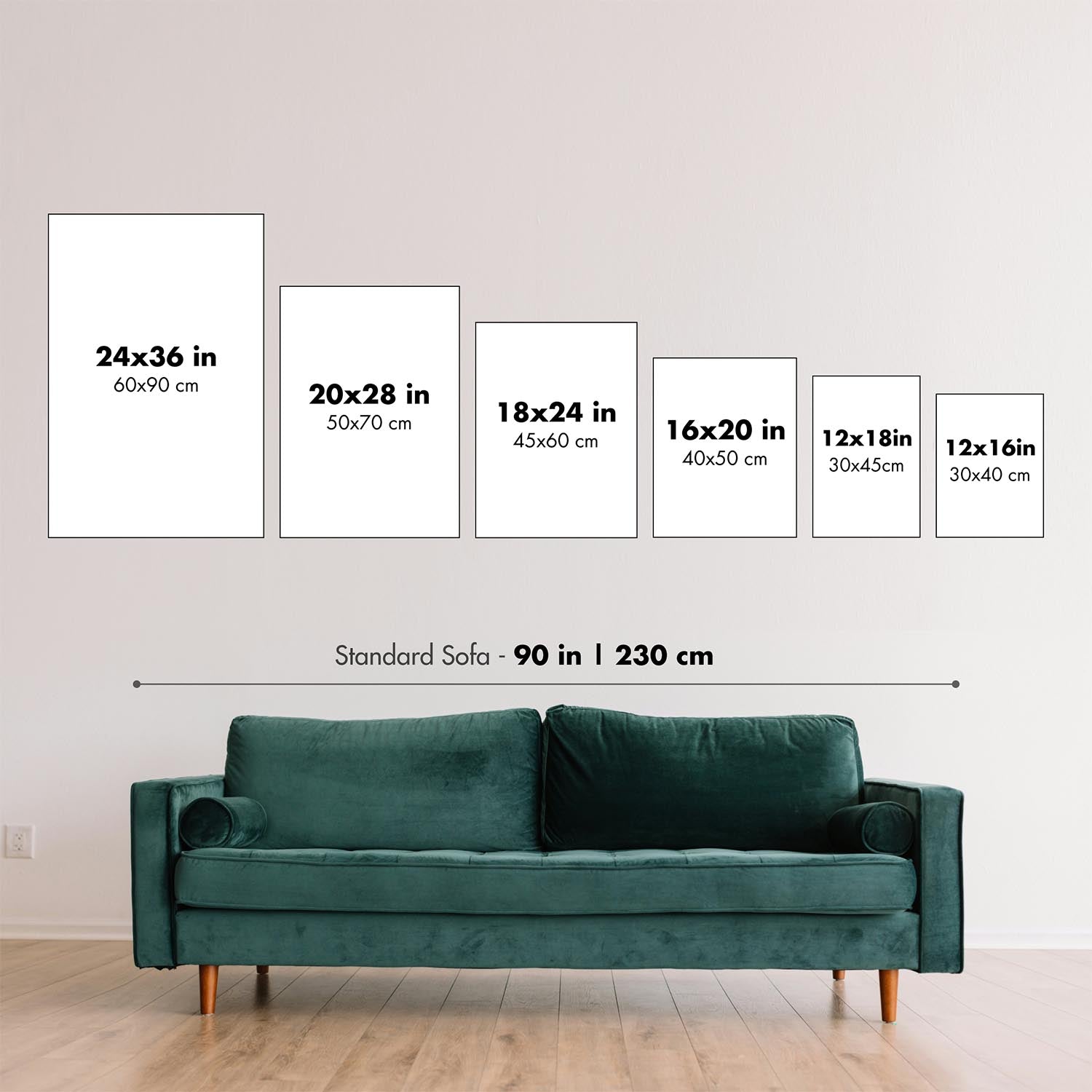
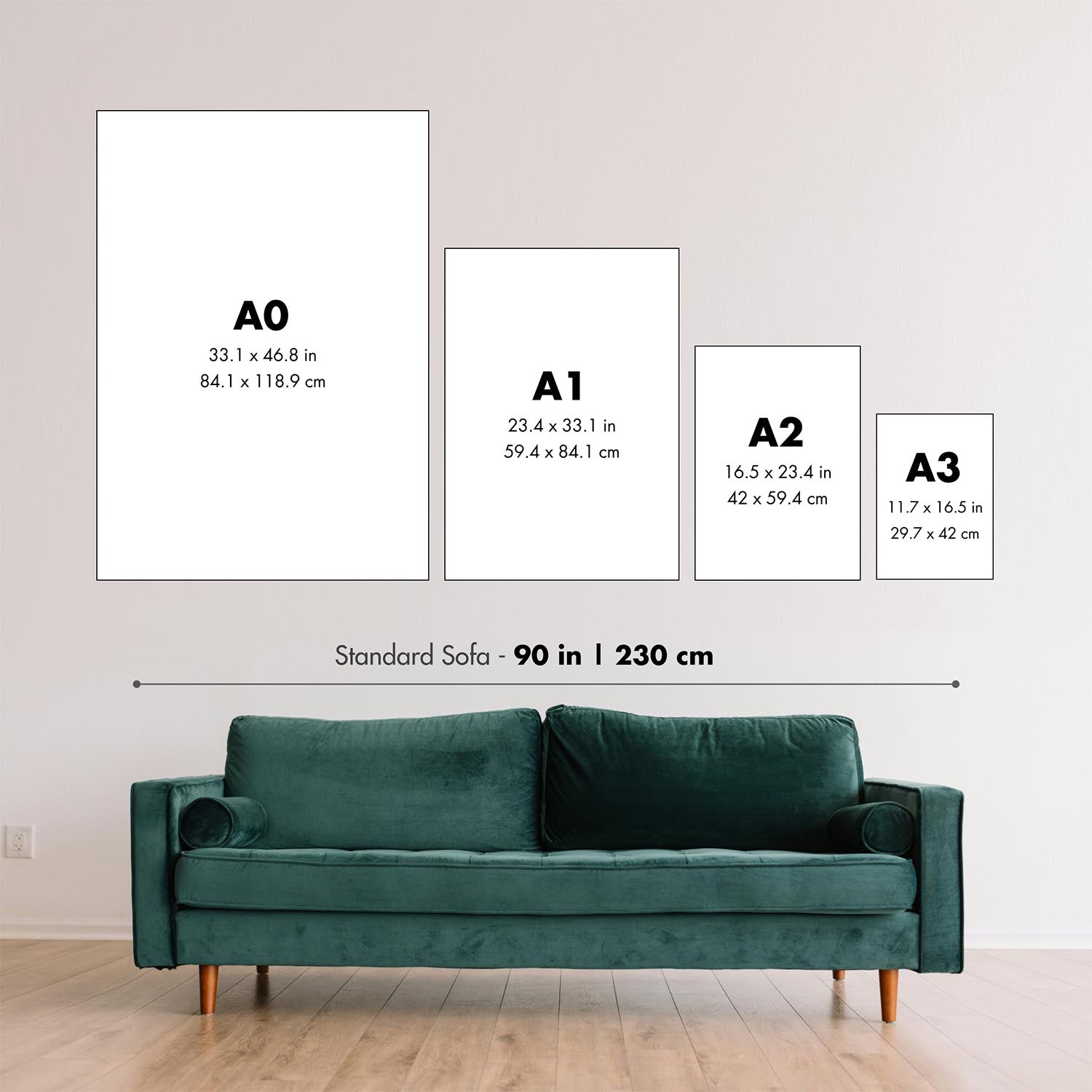
Old Pictorial Map of Delhi Durbar by Wymer, 1911: Coronation Pavilion, Park, Kingsway, Regiments, Elephants


-
![]() Handmade in Canada
Handmade in Canada
-
FREE worldwide delivery in 2-3 days ⓘ
Free delivery in 2-3 days
Your map should be delivered in 2-3 working days with free delivery, worldwide.
We make maps by hand locally in 23 countries, including Canada
![]() . If you're buying a gift for someone in another country, we will make the map locally to them.
. If you're buying a gift for someone in another country, we will make the map locally to them.You will never pay import tax or customs duty.
Express delivery is available at checkout which can reduce the delivery time to 1-2 days.
Please note that personalised maps, and larger framed maps, can take longer to produce and deliver.
If you need your order to arrive by a certain date, contact me and we can discuss your options.
-
90 day money back guarantee
ⓘ
90 days to return and refund
Products can be returned within 90 days for a full refund, or exchange for another product.
For personalised and custom made items, we may offer you store credit or a non-expiring gift card, as we cannot resell personalised orders.
If you have any questions, get in touch. For more information, see our full returns & exchanges policy.

My maps are rare, museum-grade, restored old maps sourced from libraries, auction houses and private collections across the globe.
Framing & free personalisation available
1. Select your size
➢ Pick the closest size (above)
➢ Provide the exact size in millimetres
➢ Add to bag and checkout as normal
Click here to order a custom size.
2. Frame & personalise your map
Make your map unique with framing, hand-drawn customisation, vintage ageing, pop art text, unique 3D styling and moreGift message & custom finish

If you want to add a gift message, or a finish (jigsaw, aluminium board, etc.) that is not available here, please request it in the "order note" when you check out.
Every order is custom made, so if you need the size adjusted slightly, or printed on an unusual material, just let us know. We've done thousands of custom orders over the years, so there's (almost) nothing we can't manage.
You can also contact us before you order, if you prefer!

- Handmade locally. No import duty or tax
- FREE Delivery. Arrives in 2-3 days
- Love it or your money back
- Questions? WhatsApp me any time
Own a piece of history
5,000+ 5 star reviews


The "Delhi Durbar, 1911" map, created by the esteemed military painter and illustrator Reginald Augustus Wymer, is a captivating piece that commemorates a pivotal event in the history of British India. This map, originally crafted to mark the grand Delhi Durbar of 1911, offers a detailed and evocative glimpse into the heart of colonial Delhi during the height of the British Empire. The Durbar, attended by Emperor George V and Empress Queen Mary, was a grand assembly at Coronation Park, celebrating the sovereign's succession. Wymer's map is not just a geographical representation but a historical tapestry that intertwines the city's layout with rich illustrations of the era's vibrant colonial life.
This city map is notable for its intricate depiction of significant neighborhoods and landmarks that were central to the Delhi Durbar. The Coronation Pavilion, a key feature of the Durbar, stands prominently, symbolizing the imperial grandeur of the event. Surrounding the map are detailed illustrations of various regiments, including the Queen's own Cameron Highlanders and the 1st King George's own Gurkha Rifles, showcasing the military might and ceremonial splendor of the British Empire. These visual elements not only enhance the map's aesthetic appeal but also provide a deeper understanding of the historical context and the cultural dynamics of early 20th-century Delhi.
Wymer's artistry extends beyond mere cartography; it captures the essence of colonial Indian life through vivid scenes of village life, elephant processions, and packhorse trails. These illustrations offer a window into the daily activities and ceremonial practices that defined the period. The map's depiction of various battle scenes and military activities further underscores the strategic importance of Delhi as a colonial stronghold. Each element is meticulously rendered, reflecting Wymer's renowned accuracy and his ability to bring historical narratives to life through his artwork.
The map also highlights the city's intricate network of streets and roads, with notable thoroughfares such as Kingsway, Queen's Road, and Victoria Road prominently labeled. These streets, steeped in history, connect various parts of the city and lead to significant sites like the Coronation Park and other military and administrative centers. The detailed representation of these roadways provides valuable insights into the urban planning and infrastructure of Delhi during the British Raj, making it an essential resource for historians and enthusiasts of colonial history.
In addition to its historical significance, the "Delhi Durbar, 1911" map is a testament to Wymer's artistic prowess and his contribution to the field of military illustration. His works, collected by Queen Victoria herself, are celebrated for their precision and historical accuracy. This map, with its rich visual and historical content, stands as a remarkable example of Wymer's legacy, offering a unique blend of cartographic detail and artistic expression. It is not just a map but a historical document that encapsulates the grandeur and complexity of the Delhi Durbar, making it a prized possession for collectors and history aficionados alike.
Streets and roads on this map
- Alexandra Road
- Alipore Road
- Barrack Road
- Cavalry Road
- Edward Road
- Flagstaff Road
- Hospital Road
- Jail Road
- King George's Avenue
- Kingsway
- Lothian Road
- Magazine Road
- Mall Road
- Military Road
- Nicholson Road
- North Road
- Parade Road
- Queen's Road
- Rajpura Road
- Ridge Road
- Roshanara Road
- Shalimar Road
- Smith Road
- Subzi Mandi Road
- Victoria Road
Notable Features & Landmarks
- Illustrations:
- Elephant procession
- Various regiments, including the Queen's own Cameron Highlanders and 1st King George's own Gurkha Rifles
- Village scene
- Packhorse trail
- Scenes of battle
- Coronation Pavilion
- Horse riders and soldiers in various activities
- Landmarks:
- Coronation Pavilion
- Large parks:
- Coronation Park
Historical and design context
- Fascinating map of a portion of the city of Delhi, commemorating the Delhi Durbar.
- Originally printed on Linen, giving it an interesting texture.
- The map shows a small part of Delhi, surrounded by beautiful illustrations of the Durbar.
- The Delhi Durbar was a mass assembly at Coronation Park, Delhi, India, to mark the succession of an Emperor.
- Also known as the Imperial Durbar, it was held three times: in 1877, 1903, and 1911, at the height of the British Empire.
- The 1911 Durbar was the only one attended by the sovereign, George V and Queen Mary as Emperor and Empress of India.
- This map was originally a handkerchief printed with a detailed map of the park, in brown ink, with its own railway station, and fascinating scenes from colonial Indian life.
- Created by Reginald Augustus Wymer, a military painter and illustrator.
- Wymer's works were renowned for their accuracy and were collected by Queen Victoria.
- The map includes scenes from colonial Indian life, such as the Queen's own Cameron Highlanders, 1st King George's own Gurkha Rifles, and many other regiments.
- Illustrations of a village scene, an elephant procession, a packhorse trail, and scenes of battle.
- A small part of Delhi, India, is depicted.
- The map is a City Thematic and Pictorial map.
- Surrounding illustrations depict various scenes related to the Delhi Durbar and colonial Indian life.
- The map commemorates the 1911 Delhi Durbar, a significant event marking the succession of an Emperor.
- It provides a historical snapshot of colonial India during the British Empire.
Please double check the images to make sure that a specific town or place is shown on this map. You can also get in touch and ask us to check the map for you.
This map looks great at every size, but I always recommend going for a larger size if you have space. That way you can easily make out all of the details.
This map looks amazing at sizes all the way up to 50in (125cm). If you are looking for a larger map, please get in touch.
Please note: the labels on this map are hard to read if you order a map that is 20in (50cm) or smaller. The map is still very attractive, but if you would like to read the map easily, please buy a larger size.
The model in the listing images is holding the 16x20in (40x50cm) version of this map.
The fifth listing image shows an example of my map personalisation service.
If you’re looking for something slightly different, check out my collection of the best old maps to see if something else catches your eye.
Please contact me to check if a certain location, landmark or feature is shown on this map.
This would make a wonderful birthday, Christmas, Father's Day, work leaving, anniversary or housewarming gift for someone from the areas covered by this map.
This map is available as a giclée print on acid free archival matte paper, or you can buy it framed. The frame is a nice, simple black frame that suits most aesthetics. Please get in touch if you'd like a different frame colour or material. My frames are glazed with super-clear museum-grade acrylic (perspex/acrylite), which is significantly less reflective than glass, safer, and will always arrive in perfect condition.
This map is also available as a float framed canvas, sometimes known as a shadow gap framed canvas or canvas floater. The map is printed on artist's cotton canvas and then stretched over a handmade box frame. We then "float" the canvas inside a wooden frame, which is available in a range of colours (black, dark brown, oak, antique gold and white). This is a wonderful way to present a map without glazing in front. See some examples of float framed canvas maps and explore the differences between my different finishes.
For something truly unique, this map is also available in "Unique 3D", our trademarked process that dramatically transforms the map so that it has a wonderful sense of depth. We combine the original map with detailed topography and elevation data, so that mountains and the terrain really "pop". For more info and examples of 3D maps, check my Unique 3D page.
For most orders, delivery time is about 3 working days. Personalised and customised products take longer, as I have to do the personalisation and send it to you for approval, which usually takes 1 or 2 days.
Please note that very large framed orders usually take longer to make and deliver.
If you need your order to arrive by a certain date, please contact me before you order so that we can find the best way of making sure you get your order in time.
I print and frame maps and artwork in 23 countries around the world. This means your order will be made locally, which cuts down on delivery time and ensures that it won't be damaged during delivery. You'll never pay customs or import duty, and we'll put less CO2 into the air.
All of my maps and art prints are well packaged and sent in a rugged tube if unframed, or surrounded by foam if framed.
I try to send out all orders within 1 or 2 days of receiving your order, though some products (like face masks, mugs and tote bags) can take longer to make.
If you select Express Delivery at checkout your order we will prioritise your order and send it out by 1-day courier (Fedex, DHL, UPS, Parcelforce).
Next Day delivery is also available in some countries (US, UK, Singapore, UAE) but please try to order early in the day so that we can get it sent out on time.
My standard frame is a gallery style black ash hardwood frame. It is simple and quite modern looking. My standard frame is around 20mm (0.8in) wide.
I use super-clear acrylic (perspex/acrylite) for the frame glass. It's lighter and safer than glass - and it looks better, as the reflectivity is lower.
Six standard frame colours are available for free (black, dark brown, dark grey, oak, white and antique gold). Custom framing and mounting/matting is available if you're looking for something else.
Most maps, art and illustrations are also available as a framed canvas. We use matte (not shiny) cotton canvas, stretch it over a sustainably sourced box wood frame, and then 'float' the piece within a wood frame. The end result is quite beautiful, and there's no glazing to get in the way.
All frames are provided "ready to hang", with either a string or brackets on the back. Very large frames will have heavy duty hanging plates and/or a mounting baton. If you have any questions, please get in touch.
See some examples of my framed maps and framed canvas maps.
Alternatively, I can also supply old maps and artwork on canvas, foam board, cotton rag and other materials.
If you want to frame your map or artwork yourself, please read my size guide first.
My maps are extremely high quality reproductions of original maps.
I source original, rare maps from libraries, auction houses and private collections around the world, restore them at my London workshop, and then use specialist giclée inks and printers to create beautiful maps that look even better than the original.
My maps are printed on acid-free archival matte (not glossy) paper that feels very high quality and almost like card. In technical terms the paper weight/thickness is 10mil/200gsm. It's perfect for framing.
I print with Epson ultrachrome giclée UV fade resistant pigment inks - some of the best inks you can find.
I can also make maps on canvas, cotton rag and other exotic materials.
Learn more about The Unique Maps Co.
Map personalisation
If you're looking for the perfect anniversary or housewarming gift, I can personalise your map to make it truly unique. For example, I can add a short message, or highlight an important location, or add your family's coat of arms.
The options are almost infinite. Please see my map personalisation page for some wonderful examples of what's possible.
To order a personalised map, select "personalise your map" before adding it to your basket.
Get in touch if you're looking for more complex customisations and personalisations.
Map ageing
I have been asked hundreds of times over the years by customers if they could buy a map that looks even older.
Well, now you can, by selecting Aged before you add a map to your basket.
All the product photos you see on this page show the map in its Original form. This is what the map looks like today.
If you select Aged, I will age your map by hand, using a special and unique process developed through years of studying old maps, talking to researchers to understand the chemistry of aging paper, and of course... lots of practice!
If you're unsure, stick to the Original colour of the map. If you want something a bit darker and older looking, go for Aged.
If you are not happy with your order for any reason, contact me and I'll get it fixed ASAP, free of charge. Please see my returns and refund policy for more information.
I am very confident you will like your restored map or art print. I have been doing this since 1984. I'm a 5-star Etsy seller. I have sold tens of thousands of maps and art prints and have over 5,000 real 5-star reviews. My work has been featured in interior design magazines, on the BBC, and on the walls of dozens of 5-star hotels.
I use a unique process to restore maps and artwork that is massively time consuming and labour intensive. Hunting down the original maps and illustrations can take months. I use state of the art and eye-wateringly expensive technology to scan and restore them. As a result, I guarantee my maps and art prints are a cut above the rest. I stand by my products and will always make sure you're 100% happy with what you receive.
Almost all of my maps and art prints look amazing at large sizes (200cm, 6.5ft+) and I can frame and deliver them to you as well, via special oversized courier. Contact me to discuss your specific needs.
Or try searching for something!
This service is currently unavailable,
sorry for the inconvenience.
Pair it with a frame
Frame options are for visualization purposes only.
FRAME STYLE
MATTING SIZE
BUILDING YOUR EXPERIENCE
powered by Blankwall
Take a few steps back and let your camera see more of the scene.
powered by Blankwall
Was this experience helpful?
The "Delhi Durbar, 1911" map, created by the esteemed military painter and illustrator Reginald Augustus Wymer, is a captivating piece that commemorates a pivotal event in the history of British India. This map, originally crafted to mark the grand Delhi Durbar of 1911, offers a detailed and evocative glimpse into the heart of colonial Delhi during the height of the British Empire. The Durbar, attended by Emperor George V and Empress Queen Mary, was a grand assembly at Coronation Park, celebrating the sovereign's succession. Wymer's map is not just a geographical representation but a historical tapestry that intertwines the city's layout with rich illustrations of the era's vibrant colonial life.
This city map is notable for its intricate depiction of significant neighborhoods and landmarks that were central to the Delhi Durbar. The Coronation Pavilion, a key feature of the Durbar, stands prominently, symbolizing the imperial grandeur of the event. Surrounding the map are detailed illustrations of various regiments, including the Queen's own Cameron Highlanders and the 1st King George's own Gurkha Rifles, showcasing the military might and ceremonial splendor of the British Empire. These visual elements not only enhance the map's aesthetic appeal but also provide a deeper understanding of the historical context and the cultural dynamics of early 20th-century Delhi.
Wymer's artistry extends beyond mere cartography; it captures the essence of colonial Indian life through vivid scenes of village life, elephant processions, and packhorse trails. These illustrations offer a window into the daily activities and ceremonial practices that defined the period. The map's depiction of various battle scenes and military activities further underscores the strategic importance of Delhi as a colonial stronghold. Each element is meticulously rendered, reflecting Wymer's renowned accuracy and his ability to bring historical narratives to life through his artwork.
The map also highlights the city's intricate network of streets and roads, with notable thoroughfares such as Kingsway, Queen's Road, and Victoria Road prominently labeled. These streets, steeped in history, connect various parts of the city and lead to significant sites like the Coronation Park and other military and administrative centers. The detailed representation of these roadways provides valuable insights into the urban planning and infrastructure of Delhi during the British Raj, making it an essential resource for historians and enthusiasts of colonial history.
In addition to its historical significance, the "Delhi Durbar, 1911" map is a testament to Wymer's artistic prowess and his contribution to the field of military illustration. His works, collected by Queen Victoria herself, are celebrated for their precision and historical accuracy. This map, with its rich visual and historical content, stands as a remarkable example of Wymer's legacy, offering a unique blend of cartographic detail and artistic expression. It is not just a map but a historical document that encapsulates the grandeur and complexity of the Delhi Durbar, making it a prized possession for collectors and history aficionados alike.
Streets and roads on this map
- Alexandra Road
- Alipore Road
- Barrack Road
- Cavalry Road
- Edward Road
- Flagstaff Road
- Hospital Road
- Jail Road
- King George's Avenue
- Kingsway
- Lothian Road
- Magazine Road
- Mall Road
- Military Road
- Nicholson Road
- North Road
- Parade Road
- Queen's Road
- Rajpura Road
- Ridge Road
- Roshanara Road
- Shalimar Road
- Smith Road
- Subzi Mandi Road
- Victoria Road
Notable Features & Landmarks
- Illustrations:
- Elephant procession
- Various regiments, including the Queen's own Cameron Highlanders and 1st King George's own Gurkha Rifles
- Village scene
- Packhorse trail
- Scenes of battle
- Coronation Pavilion
- Horse riders and soldiers in various activities
- Landmarks:
- Coronation Pavilion
- Large parks:
- Coronation Park
Historical and design context
- Fascinating map of a portion of the city of Delhi, commemorating the Delhi Durbar.
- Originally printed on Linen, giving it an interesting texture.
- The map shows a small part of Delhi, surrounded by beautiful illustrations of the Durbar.
- The Delhi Durbar was a mass assembly at Coronation Park, Delhi, India, to mark the succession of an Emperor.
- Also known as the Imperial Durbar, it was held three times: in 1877, 1903, and 1911, at the height of the British Empire.
- The 1911 Durbar was the only one attended by the sovereign, George V and Queen Mary as Emperor and Empress of India.
- This map was originally a handkerchief printed with a detailed map of the park, in brown ink, with its own railway station, and fascinating scenes from colonial Indian life.
- Created by Reginald Augustus Wymer, a military painter and illustrator.
- Wymer's works were renowned for their accuracy and were collected by Queen Victoria.
- The map includes scenes from colonial Indian life, such as the Queen's own Cameron Highlanders, 1st King George's own Gurkha Rifles, and many other regiments.
- Illustrations of a village scene, an elephant procession, a packhorse trail, and scenes of battle.
- A small part of Delhi, India, is depicted.
- The map is a City Thematic and Pictorial map.
- Surrounding illustrations depict various scenes related to the Delhi Durbar and colonial Indian life.
- The map commemorates the 1911 Delhi Durbar, a significant event marking the succession of an Emperor.
- It provides a historical snapshot of colonial India during the British Empire.
Please double check the images to make sure that a specific town or place is shown on this map. You can also get in touch and ask us to check the map for you.
This map looks great at every size, but I always recommend going for a larger size if you have space. That way you can easily make out all of the details.
This map looks amazing at sizes all the way up to 50in (125cm). If you are looking for a larger map, please get in touch.
Please note: the labels on this map are hard to read if you order a map that is 20in (50cm) or smaller. The map is still very attractive, but if you would like to read the map easily, please buy a larger size.
The model in the listing images is holding the 16x20in (40x50cm) version of this map.
The fifth listing image shows an example of my map personalisation service.
If you’re looking for something slightly different, check out my collection of the best old maps to see if something else catches your eye.
Please contact me to check if a certain location, landmark or feature is shown on this map.
This would make a wonderful birthday, Christmas, Father's Day, work leaving, anniversary or housewarming gift for someone from the areas covered by this map.
This map is available as a giclée print on acid free archival matte paper, or you can buy it framed. The frame is a nice, simple black frame that suits most aesthetics. Please get in touch if you'd like a different frame colour or material. My frames are glazed with super-clear museum-grade acrylic (perspex/acrylite), which is significantly less reflective than glass, safer, and will always arrive in perfect condition.












